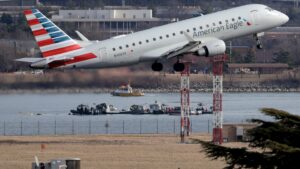A Wake-Up Call: Tragic Plane Collision Highlights Airspace Congestion Concerns
On January 30, 2025, an American Airlines regional jet tragically collided with a military helicopter while approaching Reagan National Airport in Washington, D.C. As rescue teams continue to recover bodies from the frigid waters of the Potomac River, the nation faces its deadliest commercial aviation disaster since 2001—a stark reminder of the growing issues surrounding airspace congestion.
The Incident: A Clear Need for Change
The accident occurred just before 9 PM ET, involving an American Airlines Bombardier CRJ700 carrying 60 passengers and four crew members, and an Army Black Hawk helicopter with three personnel on board. Tragically, there were no survivors from either aircraft. As the investigation unfolds, authorities have stated that initial assessments do not point to air traffic control as the cause of the collision, marking a critical juncture in understanding how such incidents can occur in heavily trafficked airways.
Similar close calls have raised alarms within the aviation industry. In April 2024, a JetBlue flight at Reagan National Airport came perilously close to colliding with a Southwest Airlines aircraft while both were on the runway. Though effective emergency protocols may have prevented a catastrophe then, the latest incident illustrates a dire need for systemic reform.
The Underlying Crisis of Airspace Congestion
The U.S. aviation system has encountered repeated close calls and minor incidents over the past several years. This recent tragedy underscores the necessity for upgraded infrastructure in air traffic control and the hiring of additional personnel. Current data shows that Ronald Reagan Washington National Airport is the busiest runway in the country, and as traffic continues to grow, so do the risks associated with managing that traffic.
Southwest Airlines CEO Bob Jordan has called for modernization of air traffic control systems, noting the existing equipment is outdated—some dating back to the 1960s. "You can’t just keep putting Band-Aids on a system that has been in need of modernization for literally decades now," he stated during an interview with CNBC. According to experts at Extreme Investor Network, the potential improvements in air traffic management could enhance safety and efficiency, ensuring that the rise in air travel does not come at the cost of disaster.
Looking Ahead: The Future of Air Travel
While airline executives assert that the overall system is as safe as it has ever been, industry leaders demand immediate action to address vulnerabilities. Comprehensive reform could lead to better traffic management, meaning that the air travel experience will not only be improved for passengers but also safer for all involved.
As the investigation continues, the aviation community must engage in a robust dialogue about the lessons learned from this tragic event. At Extreme Investor Network, we believe that proactive steps towards modernization and enhanced safety protocols are paramount in safeguarding the future of air travel.
In conclusion, as we reflect on this painful incident, let it spur on a broader conversation about reforming our outdated systems and prioritizing passenger safety in a congested aviation landscape. We invite our readers to stay informed and engaged as we delve deeper into these issues, seeking solutions to ensure tragedies like this become a thing of the past.
For further updates and in-depth analysis, subscribe to Extreme Investor Network and join the movement for change in the aviation industry!

